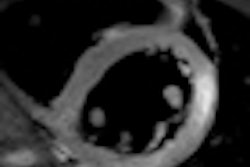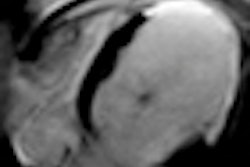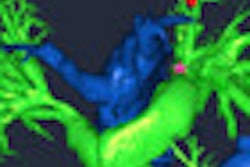MRI opens a window into heart disease that is more specialized and in many ways more powerful than other imaging methods. Still, many of MRI's best diagnostic tools remain clumsy and time-consuming, its images burdened by artifacts, and its results unproven, said Dr. Jeanette Schulz-Menger at the 2011 Scientific Symposium on Ultrahigh Field Magnetic Resonance in Berlin. But with time and help from physicists and engineers, she said, the future of cardiac MRI (CMR) seems nearly boundless.
Speaking as a research cardiologist to an audience dominated by physicists and engineers at the Berlin Ultrahigh-Field Facility (BUFF), Schultz-Menger said in daily clinical life, pretty MR images are beside the point. It's finding what you need to know to treat a particular patient that matters -- a fact that's often neglected in the rush for technology.
"The main question is, what do I need to know that is significant," Shultz-Menger said. "MRI is not only about what can I see, which is about spatial resolution. The question is, what do I have to find to answer the clinical questions -- and I want to bring you some ideas and thoughts."
Shulz-Menger is a researcher at Berlin's Charité University Experimental Research Center and BUFF, and the HELIOS Clinic for Cardiology and Nephrology. Each of the modalities from echo to CT to CMR offers unique information about the patient, she said.
"Echo can have nice 3D coverage of function, and it can give a lot of information regarding perfusion," she said. "CT is superior in the assessment of arteries, but CMR has the possibility to step into the myocardial tissue -- and that's just the point. Often as cardiologists we have the problem where we see a wall perfusion abnormality but we really don't know what is behind it."
Better than any other modality, MRI shows clues in the myocardial tissue that help explain the abnormality, refine the diagnosis, and improve patient management, she said.
One example is the diagnostic power of T2 noncontrast imaging of myocardial edema. "Edema is just a reversible myocardial injury," she said. "And to see a reversible injury really gives us a lot of chances in cardiology."
Then there is the 3D imaging, which offers its own substantial opportunities for assessing the myocardium. But in MRI, 3D is more difficult than in echocardiology and more difficult today than it should be, she said.
"Today we're able to run 3D coverage of the left ventricle and the right ventricle but the geometry makes it much harder [in MRI compared with echocardiography] to assess, and we have to put some work into it," she said. Still, "We want to guide clinical decision-making, therefore we love to use CMR," Shulz-Menger added.
Improvements in 3D quanitification mean the technique can be applied from the base to the apex of the ventricle, delivering accurate numbers that are accepted as the gold standard in myocardial tissue imaging.
But daily clinical work isn't about 3D coverage -- for now limitations prevent such an approach, she said, and clinical decision-making remains 2D-based.
"If you only run 3D you may not save enough time for your clinical routine," she said. "We have to distinguish between clinical and research scanning. And if I focus on clinical decision-making, I really don't need much accuracy in 3D assessment. I need different information."
Tranmurality of infarcts
The key advantage of MRI lies in the analysis of myocardial infarction, Shulz-Menger said. In the example she showed of a 35-year-old patient with severely decreased ejection fraction (EF), a brightly enhanced spot on the myocardium revealed a severe infarction behind it. But how serious is the infarct and how should the patient be treated? Here quantitative MRI can help.
Currently, patients with EF of less than 10% routinely receive implantable cardioverter-defibrillators (ICD); however, there can be complications associated with its use, Shulz-Menger said.
"Recently, my colleagues (Ingkarnison et al) were able to show that with 3D quantification of the scar itself -- slice by slice -- they are able discover who are the persons who really [benefit] from the ICD and who are not" based on the transmurality of the scar at adenosine stress perfusion CMR, she said.
Significant differences in survival without new cardiovascular events were seen in patients demonstrating less transmurality of the myocardial scar, according to Shulz-Menger.
Unfortunately, the slice-by-slice quantification technique is cumbersome and time-consuming, she said. "We need a very fast differentiation/quantification of this 3D assessment of the scar and its transmurality," she added.
Far more interesting to Shulz-Menger are the unique capabilities of CMR with regard to imaging water content in acute edema -- performed with noncontrast T2-weighted images. "By visualizing the edema we can improve the therapy," she said.
Microvascular obstruction
Another important finding in myocardial infarction is that of microvascular obstruction. In 2010 Bekkers and colleagues revealed new insights on the differentiation of gray noninfarcted areas of the myocardium at risk (structurally intact microvasculature and hyperemia) from bright infracted areas (intact microvasculature, low reflow, hyperemia, impaired flow reserve) and dark infracted areas (structurally damaged microvasculature, microvascular obstruction/no reflow).
In microvascular obstruction the appearance of the scar is abnormal. "The black microvascular obstruction is a mixture of bleeding hemorrhage and vascular obstruction -- so bleeding after revascularization," Schulz-Menger said. "It tells us something about the survival of the patients, and it's interesting that it also happens in patients with nonocclusive coronary artery disease."
With luck the at-risk regions of the myocardium can be saved, she said. Following patients with CMR has also provided new insight into the prognosis of patients with low EF. CMR has shown, for example, that patients with microvascular obstruction have much worse survival compared with other patients with similar ejection fractions.
"This is information you can only get with CMR," Shulz-Menger said. But "CMR really takes a lot of time, and there are many more changes behind myocardial injury than we know or are able to visualize today."
"The main issue in cardiology is that you have patients with wall motion abnormalities that are not too severe, and you want to know what's behind them," she said. For many cases it's simple enough to run an adenosine stress test to reveal new information about the dark regions of the less perfused myocardium.
The accuracy of adenosine stress CMR is excellent "and we also know that stress perfusion has a prognostic impact and a very high negative predictive value, as CT is also claiming for itself," Shulz-Menger said. "But when you are very sure about your MRI scan, you can say the same thing without any radiation, and you will have much more information on top like scar [information] and LV function."
Again part of the problem is time. It takes 20 to 30 minutes and a lot of experience to be able to interpret the images correctly, she said.
Another complication at stress perfusion CMR is the presence of fanning artifacts, which make it difficult to distinguish artifacts from significant perfusion defects, Shulz-Menger said. The problem is mitigated somewhat by moving to a higher-field MRI scanner, but it doesn't solve the problem entirely and additional techniques are needed, she said. Dark rim artifacts also confound interpretation and diagnosis.
The question of defect versus artifact becomes critical in patients with the kinds of subtle disease states that only MRI can distinguish -- such as coronary spasm, which can sometimes be diagnosed in patients with chest pain but no sign of significant coronary artery stenosis, Shulz-Menger said.
"Small perfusion defects in the subendocardial region may not only be artifacts, they can also be microvascular perfusion defects behind hypertension ... or endothelial dysfunction," she said.
"On one hand we have a lot of possibilities with CMR to differentiate, but on the other hand we have a lot of problems with the coronaries," she said. "We don't know what is what, so we need our clinical thinking caps and we need some help from physicists," Shulz-Menger said.
Cardiomyopathies
Her facility's registry shows 40% of CMR scans are undertaken for cardiomyopathies and inflammation; at her center, the scans have revealed intriguing new information in young people with subacute conditions, Shulz-Menger said.
Inflammation is the story of many young people who present to the emergency department with infarction-like ECG and chest pain, she said. When these patients "are lucky enough" to be sent to MRI first, the doctors are often able to demonstrate myocarditis and acute edema that would not be visible on other modalities, she said.
"CMR not only diagnoses the myocarditis, but we are able to show changes at follow-up and the reversible and irreversible findings," Shulz-Menger said. Forty percent of patients with myocarditis also demonstrate late gadolinium enhancement; 40% of patients with myocarditis also demonstrate late gadolinium enhancement beginning at follow-up, persisting for as long as 20 to 30 years, she said.
Alcohol is often the cause. The center ran a trial on binge drinking in which the volunteers drank vodka and orange juice following a two-week abstention period.
"Some young people have an inflammatory reaction; there are a lot of cardiomyopathies based on binge drinking," she said. Typically these volunteers feel very hungover, aren't able to walk fast, they have increased heart rates, and T2-weighted CMR was sensitive enough to show the inflammatory reaction and the recovery a week later, she noted.
"The point is we really need T2 weighting to visualize and quantify myocardial injury, but we have to fight for that -- the techniques aren't really robust today," and it's unclear if any of them will be validated, Shulz-Menger added. "At some point, we need a 3D assessment in one breathhold with high spatial resolution for the quantification of T2. We really hope it will work, and we know it's working in myocardial infarction. We have to learn, then we have to prove it."
Animal experiments also will be key to associating CMR findings with a wide variety of disease presentations, she said.



















